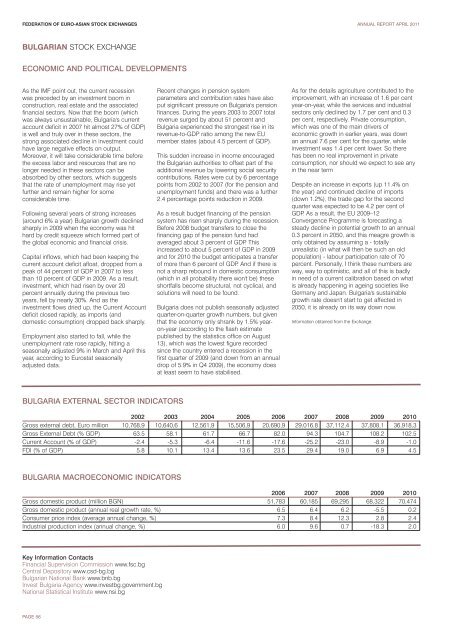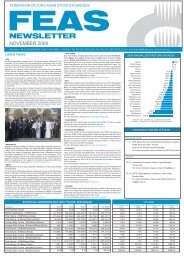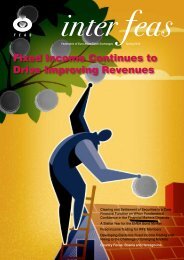Download - FEAS
Download - FEAS
Download - FEAS
Create successful ePaper yourself
Turn your PDF publications into a flip-book with our unique Google optimized e-Paper software.
FEDERATION OF EURO-ASIAN STOCK EXCHANGES ANNUAL REPORT APRIL 2011<br />
BULGARIAN STOCK EXCHANGE<br />
ECONOMIC AND POLITICAL DEVELOPMENTS<br />
As the IMF point out, the current recession<br />
was preceded by an investment boom in<br />
construction, real estate and the associated<br />
financial sectors. Now that the boom (which<br />
was always unsustainable, Bulgaria's current<br />
account deficit in 2007 hit almost 27% of GDP)<br />
is well and truly over in these sectors, the<br />
strong associated decline in investment could<br />
have large negative effects on output.<br />
Moreover, it will take considerable time before<br />
the excess labor and resources that are no<br />
longer needed in these sectors can be<br />
absorbed by other sectors, which suggests<br />
that the rate of unemployment may rise yet<br />
further and remain higher for some<br />
considerable time.<br />
Following several years of strong increases<br />
(around 6% a year) Bulgarian growth declined<br />
sharply in 2009 when the economy was hit<br />
hard by credit squeeze which formed part of<br />
the global economic and financial crisis.<br />
Capital inflows, which had been keeping the<br />
current account deficit afloat, dropped from a<br />
peak of 44 percent of GDP in 2007 to less<br />
than 10 percent of GDP in 2009. As a result,<br />
investment, which had risen by over 20<br />
percent annually during the previous two<br />
years, fell by nearly 30%. And as the<br />
investment flows dried up, the Current Account<br />
deficit closed rapidly, as imports (and<br />
domestic consumption) dropped back sharply.<br />
Employment also started to fall, while the<br />
unemployment rate rose rapidly, hitting a<br />
seasonally adjusted 9% in March and April this<br />
year, according to Eurostat seasonally<br />
adjusted data.<br />
Recent changes in pension system<br />
parameters and contribution rates have also<br />
put significant pressure on Bulgaria's pension<br />
finances. During the years 2003 to 2007 total<br />
revenue surged by about 51 percent and<br />
Bulgaria experienced the strongest rise in its<br />
revenue-to-GDP ratio among the new EU<br />
member states (about 4.5 percent of GDP).<br />
This sudden increase in income encouraged<br />
the Bulgarian authorities to offset part of the<br />
additional revenue by lowering social security<br />
contributions. Rates were cut by 6 percentage<br />
points from 2002 to 2007 (for the pension and<br />
unemployment funds) and there was a further<br />
2.4 percentage points reduction in 2009.<br />
As a result budget financing of the pension<br />
system has risen sharply during the recession.<br />
Before 2008 budget transfers to close the<br />
financing gap of the pension fund had<br />
averaged about 3 percent of GDP. This<br />
increased to about 5 percent of GDP in 2009<br />
and for 2010 the budget anticipates a transfer<br />
of more than 6 percent of GDP. And if there is<br />
not a sharp rebound in domestic consumption<br />
(which in all probability there won't be) these<br />
shortfalls become structural, not cyclical, and<br />
solutions will need to be found.<br />
Bulgaria does not publish seasonally adjusted<br />
quarter-on-quarter growth numbers, but given<br />
that the economy only shrank by 1.5% yearon-year<br />
(according to the flash estimate<br />
published by the statistics office on August<br />
13), which was the lowest figure recorded<br />
since the country entered a recession in the<br />
first quarter of 2009 (and down from an annual<br />
drop of 5.9% in Q4 2009), the economy does<br />
at least seem to have stabilised.<br />
As for the details agriculture contributed to the<br />
improvement, with an increase of 1.6 per cent<br />
year-on-year, while the services and industrial<br />
sectors only declined by 1.7 per cent and 0.3<br />
per cent, respectively. Private consumption,<br />
which was one of the main drivers of<br />
economic growth in earlier years, was down<br />
an annual 7.6 per cent for the quarter, while<br />
investment was 1.4 per cent lower. So there<br />
has been no real improvement in private<br />
consumption, nor should we expect to see any<br />
in the near term<br />
Despite an increase in exports (up 11.4% on<br />
the year) and continued decline of imports<br />
(down 1.2%), the trade gap for the second<br />
quarter was expected to be 4.2 per cent of<br />
GDP. As a result, the EU 2009–12<br />
Convergence Programme is forecasting a<br />
steady decline in potential growth to an annual<br />
0.3 percent in 2050, and this meagre growth is<br />
only obtained by assuming a - totally<br />
unrealistic (in what will then be such an old<br />
population) - labour participation rate of 70<br />
percent. Personally, I think these numbers are<br />
way, way to optimistic, and all of this is badly<br />
in need of a current calibration based on what<br />
is already happening in ageing societies like<br />
Germany and Japan. Bulgaria's sustainable<br />
growth rate doesn't start to get affected in<br />
2050, it is already on its way down now.<br />
Information obtained from the Exchange.<br />
BULGARIA EXTERNAL SECTOR INDICATORS<br />
2002 2003 2004 2005 2006 2007 2008 2009 2010<br />
Gross external debt, Euro million 10,768,9 10,640,6 12,561,9 15,506,9 20,690,9 29,016,8 37,112,4 37,808,1 36,918,3<br />
Gross External Debt (% GDP) 63.5 58.1 61.7 66.7 82.0 94.3 104.7 108.2 102.5<br />
Current Account (% of GDP) -2.4 -5.3 -6.4 -11.6 -17.6 -25.2 -23.0 -8.9 -1.0<br />
FDI (% of GDP) 5.8 10.1 13.4 13.6 23.5 29.4 19.0 6.9 4.5<br />
BULGARIA MACROECONOMIC INDICATORS<br />
2006 2007 2008 2009 2010<br />
Gross domestic product (million BGN) 51,783 60,185 69,295 68,322 70,474<br />
Gross domestic product (annual real growth rate, %) 6.5 6.4 6.2 -5.5 0.2<br />
Consumer price index (average annual change, %) 7.3 8.4 12.3 2.8 2.4<br />
Industrial production index (annual change, %) 6.0 9.6 0.7 -18.3 2.0<br />
Key Information Contacts<br />
Financial Supervision Commission www.fsc.bg<br />
Central Depository www.csd-bg.bg<br />
Bulgarian National Bank www.bnb.bg<br />
Invest Bulgaria Agency www.investbg.government.bg<br />
National Statistical Institute www.nsi.bg<br />
PAGE 56
















